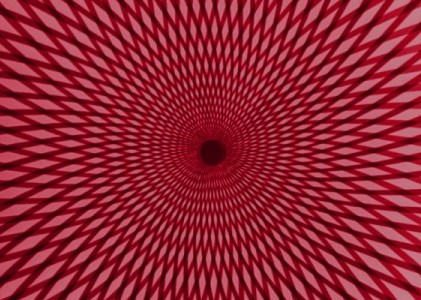Man Out of Time
Explosions, spinning globes, black-and-white animated squiggles, rapidly moving discs, pulsating moiré patterns, and a set of dancing vertical pointed lines that suggest a sort of kinetic picket fence: this intriguing barrage of imagery confronts viewers as they step into the second-floor film and video gallery at the Whitney Museum. Percussive music fills the space, alternately punctuating and pushing the onrush of imagery, a lush array of purples, greens, reds, and blues. Conceived in 1926 by animator Oskar Fischinger, the three-screen spectacle is one of the most hypnotic and mysterious films you'll see this year. But it is not, in fact, a film—at least in the conventional sense of the word—and it never was. It was something far more radical, and its historical significance and medium-specific qualities raise a host of questions about the intersection of cinematic history and the museum.
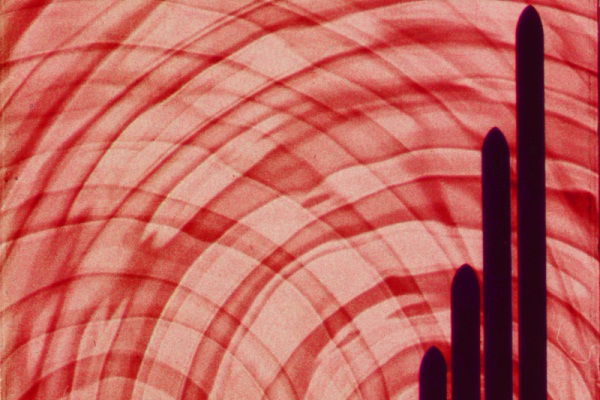
Raumlichtkunst, (c) Center for Visual Music
Fischinger's Raumlichtkunst (or "Space Light Art," as it is called at the Whitney) is a marvel of European modernism, and it stands as one of the earliest multimedia projects. Originally a live cinematic event combining multiple film projectors and slide projectors "played" by the artist, and accompanied by an independent musical soundtrack, Fischinger's media innovation also presages a host of expanded cinema, projection performance, and video-installation practices. The current installation is curated by Cindy Keefer of the Center for Visual Music (CVM), the organization responsible for the preservation and management of Fischinger's films. CVM preserved the original 35mm nitrates photochemically, and then made high definition transfers. Fischinger's brilliant colors, first achieved by a variety of hand-tinting, toning, and coloring techniques, have been immaculately restored through digital processes.
At once cosmic and down-to-earth—literally, in the case of the spinning globes that pop up repeatedly—the piece offers a forward-thinking exploration of abstract form and color, as well as providing an index of the artist's obsessions, which include visual music, geometric and kinetic abstraction, and the creation of new methods to make images move. The only appearance of the human figure is a drawing of a woman, arms outstretched, advancing toward the screen. Is she a devil, a sorceress? The answer is both far more quotidian and indicative of Fischinger's sense of humor: she is a reproduction of a beer label from Munich, where the artist lived briefly. As currently installed at the Whitney and at the Tate Modern, Raumlichtkunst runs in a 10-minute loop, in which the three projections run independently and asynchronously, producing different audio-visual combinations with each repetition.
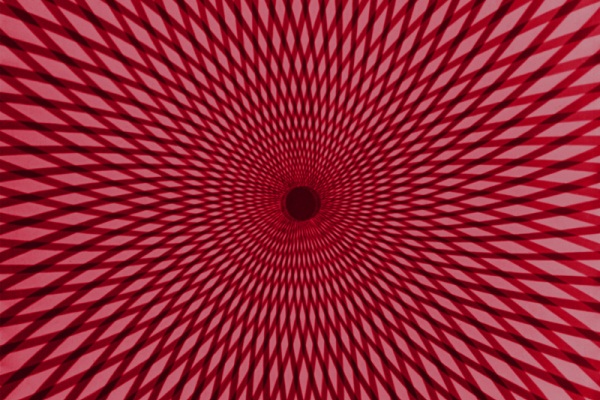
Raumlichtkunst, (c) Center for Visual Music
While no formal documentation exists of the original music used, Keefer says that Raumlichtkunst performances were accompanied by live music, and that Fischinger had written that he was intrigued by "music with no melody." CVM worked with musicologist Richard H. Brown (who has recently published on the working and conceptual relationships between Fischinger and John Cage) to select several pieces for the installation, three of which play at the Whitney: Edgard Varèse's Ionisation (1929-31), and two versions of Double Music (1941) by John Cage and Lou Harrison. The pulsing music is thus only slightly less ahead-of-its time than the dazzling visuals it accompanies.1
Raumlichtkunst is more opaque than Fischinger's better-known Kreise (Circles, 1933), Komposition in Blau (1935), and his other sprightly animations. His playful advertisements for Muratti cigarettes (Muratti Greift Ein, 1934, and Muratti Privat, 1935) were seen around the world. Fischinger's films caught Hollywood's eye and allowed him to leave Nazi Germany for Los Angeles in 1936. After making An Optical Poem (1937) for MGM, he had a disastrous stint working on Disney's Fantasia (1940). He was to animate Bach's Toccata and Fugue in D Minor for the film, but fell out with Disney after his abstract designs were transformed into representational imagery such as violin bows. Fischinger continued working with support from the Guggenheim Museum (then the Museum of Non-Objective Painting), and his films were a pivotal influence on such avant-garde filmmakers as Jordan Belson, Harry Smith, and John and James Whitney. Celebrated in Europe, and acknowledged on the West Coast by both the film and art worlds—he had one-man shows at SFMOMA and the Pasadena Museum in the 1950s—his presence in New York museums has been limited to infrequent screenings since the 1940s.
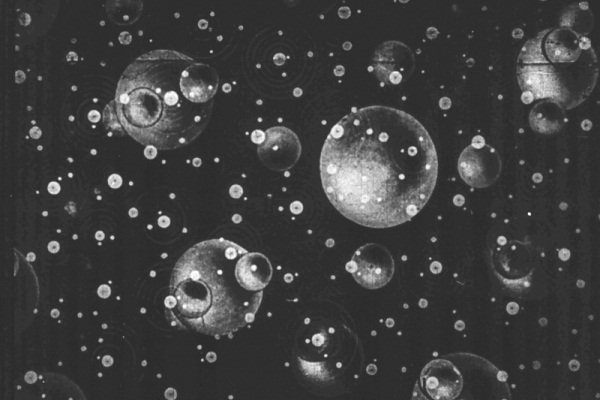
Raumlichtkunst, (c) Center for Visual Music
So why the interest now? Raumlichtkunst is a work whose time has come—again. Fischinger's art anticipates a multi-screen temporality familiar from the multiple open browser and media player windows on our computer desktops today, and in online video that utilizes what new media theorist Lev Manovich calls "spatial montage," wherein the screen is reshaped into a number of separate and simultaneous images. Raumlichtkunst is also a timely instantiation of the burgeoning art world interest in cinema's expanded field, particularly in the arena of projection performance. Artists as varied as Sandra Gibson and Luis Recoder, Bruce McClure, Guy Sherwin, Jennifer Reeves, Bradley Eros, Ben Russell, and the recently reformed psychedelic multimedia outfit the Joshua Light Show combine cinema with elements of music, sculpture, and live performance, rejecting cinematic convention in favor of rethinking the sites, modes, and meanings of the moving image. These works have been shown in spaces from galleries, microcinemas, and planetariums to museum biennials and retrospectives.
Fischinger was a 20-year-old machine engineer and aspiring artist when he was taken by a critic from the Frankfurter Zeitung to a private rehearsal screening of Walther Ruttmann's Lichtspiel: Opus I at a Frankfurt theater in April 1921. Fischinger was so impressed by Opus I—the first abstract film screened for the public—that he decided to try his hand at filmmaking. He did not wish merely to copy the style he had seen, however. True to his nature as an inventor and engineer, Fischinger developed a wax-cutting machine that allowed him to animate thin cross-sections of wax frame by frame, a process that resulted in shifting abstractions reminiscent of both tidal pools and swirling galaxies. Impressed by this innovation, Ruttmann asked Fischinger if he could license the wax-cutting machine to produce backgrounds for his animations of a flying horse for the opening sequence for Lotte Reiniger's The Adventures of Prince Achmed (1926).
Around that time, Fischinger also began collaborating with composer Alexander László on Farblichtmusik, an audio-visual extravaganza that toured theaters and cinemas throughout Germany in 1925 and 1926. Fischinger developed a system of combining multiple film projectors (though Keefer's research indicates that it might have only been a single projector) with the light effects of László's color organ. Eager to pursue his own project, it was then that Fischinger developed the concept of Raumlichtkunst. The work culled footage from many of Fischinger's film experiments, including Spirals (1926) and the deliquescing wax imagery that had so intrigued Ruttmann. Raumlichtkunst was, in many ways, a technical and aesthetic extension of the possibilities that had been introduced by Opus I and other abstract films of the time. While it is unlikely that they saw any of the Raumlichtkunst performances, Ruttmann lectured on his younger colleague's work at the Bauhaus, as did instructor-practitioner László Moholy-Nagy.
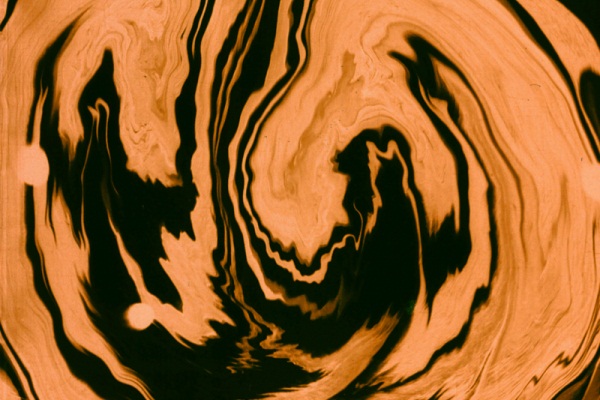
Raumlichtkunst, (c) Center for Visual Music
The Whitney's presentation of Raumlichtkunst, while undeniably gorgeous, nonetheless demonstrates the difficulty of preserving cinema's intermedial past. After all, Raumlichtkunst did not originally exist as a black-box video installation, or even as a discrete film work. The name Raumlichtkunst, in fact, describes a concept; it was a name Fischinger applied to a number of projection performances that took place in Germany in the mid 1920s. He did not think of these pieces as film, but instead, as a new art that would fulfill the promise and extend the possibilities of cinema. His performances could not be enjoyed the same way each time they were displayed—in the way that, say, Citizen Kane is the same film every time it is screened. Rather, they were unique, real-time performances, ephemeral, and at least partially reliant on the artist's aleatory selection of elements.
At the Whitney, Raumlichtkunst looks sharp, contemporary (though instances of prominent grain and some scratches hint at its true age), and more or less indistinguishable in its mode of presentation from a host of contemporary video installations. However unintentionally, this mode of presentation obscures the historically close relationships of cinema to performance and the other arts. While the radical nature of Fischinger's imagery remains, the radical nature of its original mode of address is wholly absent. The latter condition is through no fault of the curators, of course—it's not as if Fischinger were alive to conduct the work himself. Indeed, viewers should be grateful this strange wonder exists at all, in any form. CVM's Keefer is herself keenly aware of the distinctions between Raumlictkunst's original iterations and its present "recreation," as it is termed, and she promises to elaborate on these issues in detail in a forthcoming essay. Nevertheless, it is possible to imagine how an institution more attuned to the history of European modernism might have marshaled its resources in placing Fischinger's achievement in the larger context of the development of abstract art. This is, in fact, how Tate Modern has situated Raumlichtkunst with their installation, surrounded by paintings by Picasso, Matisse, Braque, Moholy-Nagy, and others.
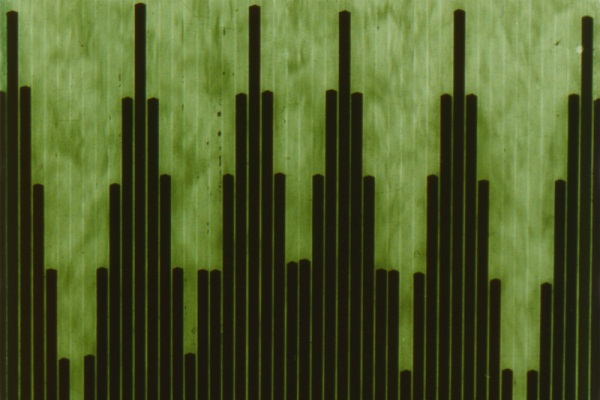
Raumlichtkunst, (c) Center for Visual Music
Fischinger's own desire to create a new art, and his employment of multiple media in doing so, productively dismantles the idea that high modernism's concerns with medium specificity were never as dominant or aesthetically rigid as previously thought. Indeed, it illuminates the close kinship between painting and cinema in Weimar Germany and throughout Europe in the 1920s and 1930s. That newspaper accounts of Fischinger's process coined the term Raumlichtkunst (Fischinger originally dubbed the concept Raumlichtmusik) are indicative of the way the work was understood in its own time as something other, or more than, conventional cinema. To this end, it is worth noting what is different about Raumlichtkunst as we see it today from what it might have been in its moment. Where the machinations and apparatus of the original would have been present in any venue that was not a traditional cinema (information about the sites of Fischinger's performances is scant), at the Whitney the work is presented in a gallery space where the bodily presence of the artist and the machines that made it possible are necessarily excised. Even though the current version's technology is on display—the video projectors and audio speakers are all visible in the space—the overall result is programmatic rather than improvisatory, and eliminates the hand-operated, moment-to-moment decision making of the artist in the act of performance. The non-cinematic elements (slides, color filters) are also not present.2
These limitations are familiar headaches for archivists and curators, complicating issues of film preservation, as well as of the museum as a site of film spectatorship. Even with the proliferation of flat-screen HD video standing in for born-analog film works, most museumgoers still think of art museums as reservoirs of the authentic—they provide the opportunity to see unique objects as they once were and continue to be. While conventional cinema can potentially thrive in the museum—indeed, select museums may soon become some of the only places where you will be able to see films projected on actual film—live cinema events like Raumlichtkunst throw up some of the same impediments to conservation and presentation as performance art. When a museum presents a "recreation" of what was a series of radical, one-time events without providing the context to fully allow viewers to appreciate what they are seeing, it underscores how works such as Raumlichtkunst that exist between mediums and that resist conventional museum exhibition practices require radical—even revolutionary—curatorial approaches. After all, sometimes even three screens aren't enough to provide the whole picture.
http://centerforvisualmusic.org/Raumlichtkunst.html
1. Fischinger biographer and historian of visual music William Moritz also used Double Music for his first attempt at recreating another of Fischinger's multi-projection pieces, R-1 ein Formspiel, in 1993.
2. Keefer says that CVM plans future live performances of Raumlichtkunst with avant-garde percussive accompaniment. These performances may also include multiple film projectors. Keefer adds that, originally, the concept of two additional slide projectors was explored for the installation; for technical reasons, this was not possible with this HD video presentation. ![]()
LATEST ARTICLES
-20140814-173707-thumb3.jpg)
Fighting Words
by Imogen Sara Smith
posted August 12, 2014

Fighting Words, Part 2
by Imogen Sara Smith
posted August 20, 2014

On the Margins: The Fil…
by Andrew Chan
posted August 12, 2014

Robin Williams: A Sense…
by David Schwartz
posted August 12, 2014
 Man Out of Time
Man Out of Time
RELATED CALENDAR ENTRY
June 28–October 28, 2012 Oskar Fischinger: Space Light Art—A Film EnvironmentKEYWORDS
experimental film | animation | German Cinema | exhibition review | Oskar Fischinger | video artist | film preservationTHE AUTHOR
Gregory Zinman, PhD, is a Visiting Assistant Professor at the Georgia Institute of Technology and a Postdoctoral Fellow at the Smithsonian American Art Museum. His writing on experimental film and media has been published in The New Yorker, American Art, and Film History.
More articles by Gregory Zinman
